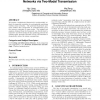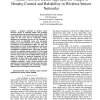865 search results - page 4 / 173 » Modeling environmental effects on directionality in wireless... |
BC
2002
13 years 7 months ago
2002
The importance of the hippocampus in spatial representation is well established. It is suggested that the rodent hippocampal network should provide an optimal substrate for the stu...
CCR
2010
13 years 7 months ago
2010
We present a sophisticated framework to systematically explore the temporal correlation in environmental monitoring wireless sensor networks. The presented framework optimizes los...
WCNC
2008
IEEE
14 years 1 months ago
2008
IEEE
A primary constraint in wireless sensor networks (WSNs) is obtaining reliable and prolonged network operation with power-limited sensor nodes. Most of the approaches to the energy ...
MOBISYS
2009
ACM
14 years 8 months ago
2009
ACM
PEIR, the Personal Environmental Impact Report, is a participatory sensing application that uses location data sampled from everyday mobile phones to calculate personalized estima...
TMC
2008
13 years 7 months ago
2008
In wireless networks, a client's locations can be estimated using signal strength received from signal transmitters. Static fingerprint-based techniques are commonly used for ...


